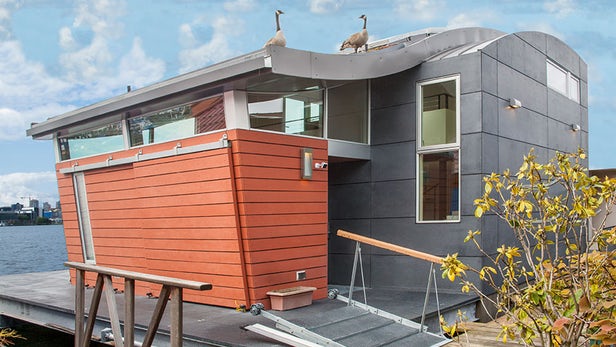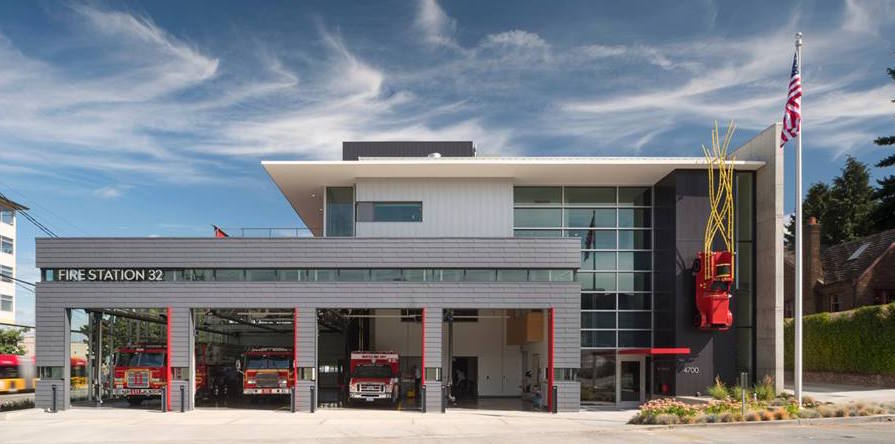In reference to its lush evergreen forests, Seattle has been labeled the “Emerald City.” But, the “Green” definition for Seattle does not end here. In fact, along with Atlanta, it has won the first round in the Bloomberg American Cities Climate Challenge. Both cities will be awarded technical support and a support package of USD 2.5 Mn each. The 2-year program will accelerate Seattle’s efforts in tackling climate change. The seaport city will continue promoting a sustainable future mainly by reducing emissions from the transit sector and improving buildings’ energy efficiency. Residents and businesses are deeply invested in creating eco-friendly environments. Let’s have a look at some of the most incredible innovations by local architects!
Houseboat H
One of the most innovative and eco-friendly houseboats in the US. A floating home that cleans the water around it! Located in Seattle’s Lake Union, it was ecologically designed so as to enrich its surroundings. Architect Michelle Lanker and her husband Bill Bloxom, through their architectural firm Lanker Design LLC, had set a goal for their property to improve water quality and create new habitats for aquatic life. The building materials were chosen to guarantee minimum maintenance and maximum durability. The houseboat collects heat from the lake and uses solar panels to generate energy, thus resulting in a net-zero home.
Amazon Plant-Filled Biospheres
Amazon, the world’s biggest online retailer, has been rethinking its workplace environments and using innovative approaches to support sustainable development. Its headquarters in Seattle have been rejuvenated with a newly added added greenhouse space, or more precisely a three-domed jungle of meeting and work space. Encompassing 3.3 million square feet and covering three city blocks, Amazon’s new offices include three 37-story high-rise office towers, a mid-rise office building, a multi-purpose meeting centre, and the “Spheres”, the centrepiece of the project. Designed by NBBJ architectural firm, the Three-Domed structure is a glass enclosed workplace holding thousands of plants from more than 30 countries. Amazon’s biosphere is aimed at improving employees’ well-being and at increasing collaboration and creativity. As part of the retailer’s sustainability efforts, one of the green campus’ towers, the Doppler building, which includes a dog park, has earned an honorable mention by AIA Seattle for “de-materializing” the bulk of the tower with dichroic glass. Several buildings in the campus have been LEED Certified.
LEED Platinum fire station
Seattle Fire Station 32 is a 18,000 square-foot fire station designed by Bohlin Cywinski Jackson, as part of the firm’s sustainable development efforts. In fact, the project has earned a LEED Platinum certification for its improved energy efficiency. The fire station, through a high level of natural daylight, a terrace overlooking a green roof as well as pleasant external views, was also built in a way so as to enhance firefighters’ well-being. In addition, its well-thought-of central location provides for quick responses of firefighters. The station’s four-story layout is a way to mitigate the apparatus bay’s compact parameters.
The Bullitt Center
The greenest office building in Seattle, The Bullitt Center, which occupies 52,000 square foot and cost $32.5Mn to build, claims to be the greenest commercial building in the world. Located at the intersection of Central District neighbourhood and Capitol Hill, it is easily accessible by foot, bike, and public transportation. The architectural firm, Miller Hull, who partnered with The Bullitt Foundation for this project, made sure to exclude on-site parkings, thus encouraging both walking and biking , and to avoid using 14 chemical categories from the Red List building materials. The Bullitt Center is one of the largest “net positive” energy buildings in the world. It was certified as a “Living Building” by the International Living Future Institute in 2015, becoming the first office building to earn this certification, the most challenging benchmark of sustainability in the built environment.
The urgency of implementing sustainable buildings practices is not to be understated. These involve material selections, technological solutions, efficient fixtures as well as choosing the right site and schematic design. Each and everyone of us need to invest in green homes. Small Steps, Big Changes.











